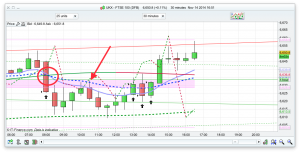There are a whole host of simple day trading strategies that can be used to successfully day trade. What is day trading? Day trading is the act of buying and selling a financial instrument within the same day, or even multiple times over the course of a day. So for example, betting on intra daily price movements of the FTSE 100. You can day trade on pretty much anything, including individual shares, commodities, forex and other global indices.
Win, don’t fail….
It is widely known that the vast majority of people that try day trading lose. You don’t have to be in that statistic and visiting this website is a great start to making sure you aren’t! Read more on this page – Why traders fail
How to become a day trader
Day trading, like any other profession, requires education and skills to consistently make a living and you can read more here on how to become a day trader
People who succeed at day trading do three things consistently:
- They identify intra-day trading strategies that are tried and tested.
- They are 100% disciplined in executing those strategies.
- They stick to a strict money management rules.
You need trading strategies
I use several different day trading strategies myself, but a simple day trading strategy to get started with involves using the 10 and 25 exponential moving averages on the 30minute time frame. You can use this on the FTSE100 but it works just as well on other markets such as the ASX200, S&P, Dax and Dow.

When 10 crosses the 25 you get the alert for the trade and then look to enter when the price touches the 25EMA. If the 10 comes up through the 25 then you are looking for long; if the 10 drops down through the 25 you are looking to go short.
By using a fast and a slow moving average with the strategy you are aiming to remove the whipsaw price action and enter into confirmed trades. This strategy is over and above simple support and resistance trading and is better for one where you are watching the price action itself.
The video below explains it in more detail.
Join now to become successful and learn more day trading strategies
This is just one of the many day trading strategies that I use. By joining my service then you get exposure to a whole raft of different strategies, as well as access to me and the other members in the live trading room.
My top 20 tips for beginners
Here are twenty day trading tips for beginners:
1. Educate Yourself: Continuously learn about trading strategies, technical analysis, fundamental analysis, risk management, and trading psychology.
2. Start with a Plan: Develop a clear trading plan that includes your goals, risk tolerance, entry and exit strategies, and position sizing.
3. Practice with a Demo Account: Use a demo account to practice trading without risking real money. This helps you gain experience and confidence.
4. Start with Adequate Capital: Begin with enough trading capital to absorb potential losses and provide ample trading opportunities.
5. Manage Risk: Implement risk management techniques such as setting stop-loss orders and using proper position sizing to protect your capital.
6. Focus on Liquid Instruments: Trade highly liquid stocks, currencies, or commodities that have sufficient trading volume and tight bid-ask spreads.
7. Follow the Trend: In day trading, it’s often beneficial to trade in the direction of the prevailing trend to increase the probability of success.
8. Use Technical Analysis: Learn and utilize technical indicators, chart patterns, and candlestick analysis to identify potential trade setups.
9. Keep a Trading Journal: Record your trades, including entry and exit points, reasons for the trade, and emotions felt. This helps you analyze and improve your trading performance.
10. Avoid Overtrading: Be selective and patient with your trades. Overtrading can lead to poor decision-making and increased transaction costs.
11. Set Realistic Expectations: Day trading is not a guaranteed path to quick riches. Have realistic expectations and focus on consistency and long-term profitability.
12. Use Limit Orders: Place limit orders to enter and exit trades at specific price levels. This helps you avoid the impact of market volatility and slippage.
13. Be Disciplined: Stick to your trading plan and avoid deviating from your strategy based on emotions or short-term market fluctuations.
14. Monitor Market News: Stay informed about relevant market news, economic indicators, and company earnings releases that can impact the instruments you trade.
15. Avoid Chasing Losses: Don’t try to make up for losses by taking excessive risks or increasing your position size. Stick to your risk management plan.
16. Avoid Trading During Volatile Market Times: High volatility can lead to unpredictable price movements and increased risk. Consider avoiding trading during major news events or volatile market periods.
17. Learn from Mistakes: Use your losing trades as learning opportunities. Analyze what went wrong and identify areas for improvement in your strategy.
18. Diversify Your Trades: Spread your trades across different instruments or sectors to reduce the risk of being overly exposed to a single position.
19. Develop a Trading Routine: Establish a structured routine for pre-market analysis, trade execution, and post-trade review. Consistency and discipline are crucial for success.
20. Stay Emotionally Balanced: Control your emotions and avoid making impulsive decisions. Emotional trading can lead to poor outcomes.







